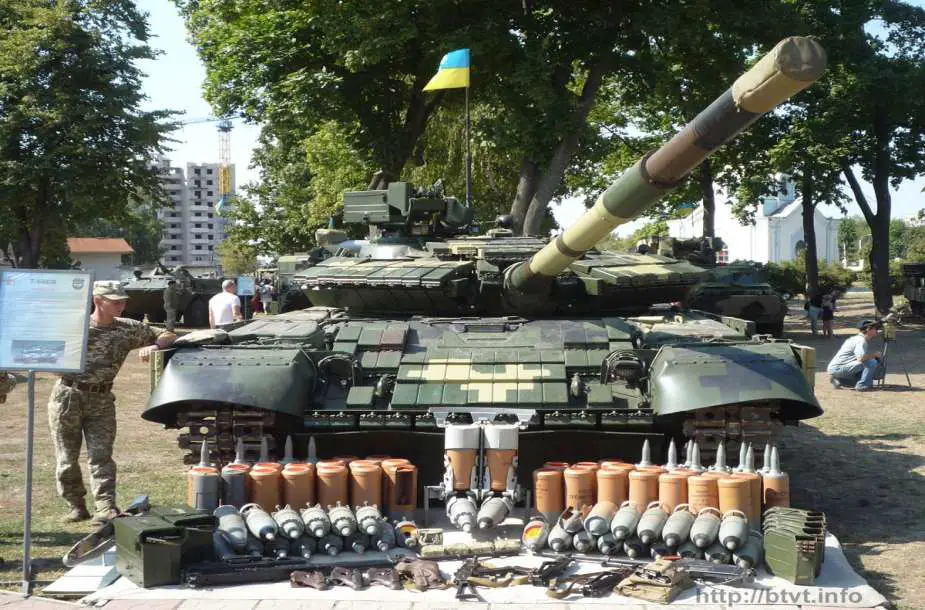- Army
- Conflicts in the world
- Israel - Iran conflict 2025
- Pakistan - India Conflict 2025
- Russia Ukraine War 2022
- Libya conflict day by day
- HAMAS - Israel War 2023
- Operation Serval in Mali French Army
- Sangaris operation Central African Republic
- Sangaris opération militaire République Centreafrique
- Ukraine - Russia conflict
- Syria conflict news
- Defence & Security Industry Technology
- Armies in the world
- Analysis Defense and Security Industry
- Conflicts in the world
- Navy
- Air
Ukrainian T-64BV tanks stand strong as Ukraine awaits massive influx of Abrams M1A1 and Leopard 1A5
While Ukraine eagerly awaits the large-scale delivery of Western tanks, its armored units are primarily engaged in combat with Soviet-era T-64BV tanks. At present, the Ukrainian army operates various iterations of the T-64 tank, originally developed and introduced by the Soviet Union. After the dissolution of the Soviet Union, Ukraine inherited a substantial number of these tanks and subsequently developed several upgraded versions.
Follow Army Recognition on Google News at this link

T-64BV, is the most widely utilized within the ranks of the Ukrainian army. (Picture source: BTVT Info)
An advancement includes the T-64BV, the most widely utilized within the ranks of the Ukrainian army, which constitutes an upgrade of the T-64B with the addition of explosive reactive armor for heightened protection. The T-64BM Bulat, a Ukrainian modernized variant of the T-64BV, presents notable enhancements in armored protection, fire control, and mobility, albeit on a smaller scale than the T-64BV. The T-64BV's production began in 1985 and benefited from enhanced anti-radiation protection and add-on explosive reactive armor.
The T-64BV layout closely resembles that of the Russian T-72 main battle tank, with the driver at the front, the combat zone in the center, and the powertrain at the rear. Equipped with the Kontakt-1 reactive armor, the T-64BV covers the glacis plate, front part of the turret, sides, roof, and hull sides up to the five roadwheels.
In terms of mobility, the T-64BV is powered by a liquid-cooled 5TDF diesel engine, generating 700 hp at 3000 rpm. It is coupled with a hydraulically assisted transmission boasting seven forward gears and one reverse gear. The T-64BV achieves a maximum road speed of 45 km/h and a cruising range of up to 600 km. For more information on the technical capabilities of the tank, we invite you to consult this page here.
However, despite its critical role, interviewed Ukrainian soldiers acknowledge the T-64BV's flaws. They point out that the engine tends to overheat rapidly, even after short journeys, necessitating stops to address the issue. Another concern pertains to the automatic loader, which, while enabling quicker reloading, is also more prone to explosion due to the turret-stored ammunition, a concern shared with Russian tanks.
Nevertheless, despite these shortcomings, the extensive use of anti-tank missiles like the Javelin and NLAW (supplied by Western powers) by Ukrainian forces partially offsets the disadvantages faced against more modern and faster Russian tanks, like the T-64BV. Notably, NLAW has reportedly destroyed around 40% of Russian armored vehicles, as reported in an article dated April 7, 2022.
Ukrainian tank crews also admit that while awaiting the large-scale delivery of Abrams M1A1 and Leopard 1A5 tanks to their armored units, capturing trophy tanks, especially the T-72, is highly appreciated. Such captures save training time, as these tanks are more modern than the T-64, requiring less maintenance and offering improved agility.
According to OSINT (Open Source Intelligence) information, since the beginning of the Russian invasion in Ukraine in February 2023, Ukrainian armored units have lost nearly 239 T-64BV tanks. The Ukrainian army had approximately 620 T-64BV tanks at the start of the conflict, this corresponds to more than a third of the deployed T-64s.
Furthermore, as previously reported in June 2023, damaged armored vehicles are being repaired by the Czechs. The Czech defense company located in Nový Jičín is poised to undertake the restoration of Ukrainian T-64 tanks, as officially announced by the Czech Ministry of Defense.


























